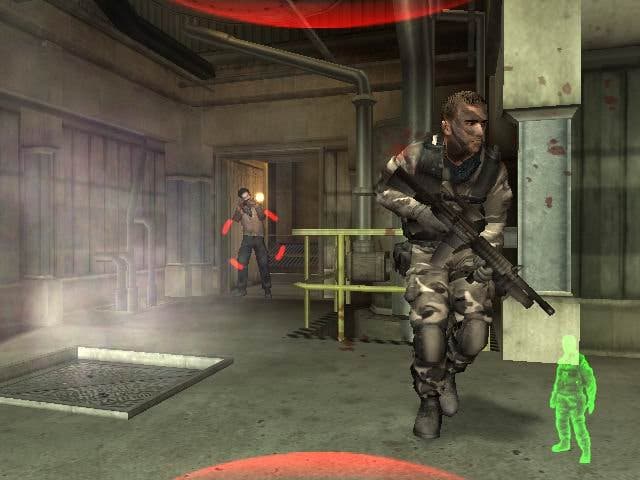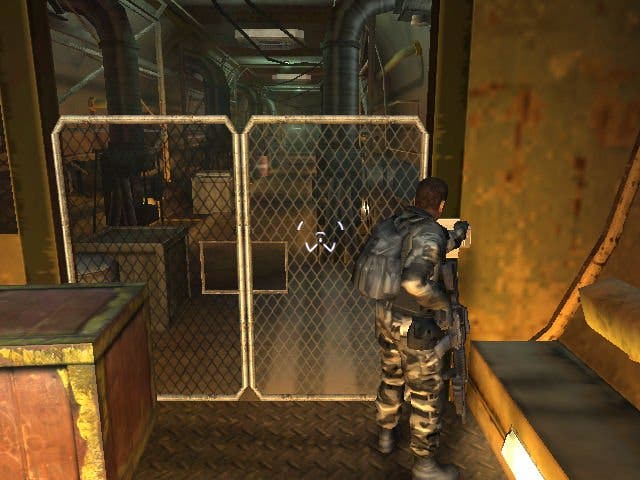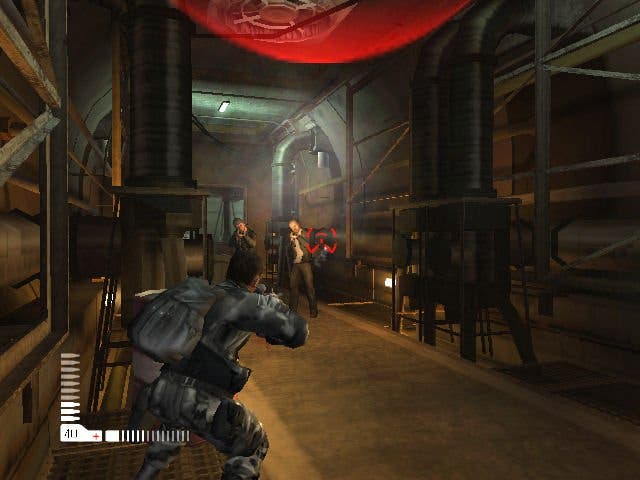A Warning Sign
Circle Studio's Adrian Smith gives an exclusive insight into the development of Without Warning, the team's first post-Tomb Raider project...
With such a vast amount of consolidation in the British development community it's rare to witness the emergence of a brand new studio - never mind one whose first project, Without Warning, has been chosen to be Capcom's first ever European signing. Made up largely of vastly experienced ex-Core Design recruits, Circle has hit the ground running with an intriguing, 24-inspired third-person action title based around 12 hours in the lives of six contrasting characters and the events that unfold in a chemical plant. With much to prove after the Angel Of Darkness debacle, we found development director Adrian Smith in determined form keen to put the company on the map for all the right reasons.
In part two of this in-depth chat, Smith discusses the genesis of Without Warning, the game's hook, the six characters, the lessons learned from Angel Of Darkness, and more...

I wouldn't say less, because we managed to balance Without Warning between an established genre. If it was a Herdy Gerdy with little pink fluffy things running round we'd have probably shut the doors by now! [laughs].
I don't know who we can actually pin it on. It started something a little bit more humble than it is today, and we always knew that we had to find a hook. I think our intention was to bring something to market that wasn't massively innovative in so far as it wasn't going to be pink fluffy things wandering around. It was something that we understood; I think our unique side is we've got a perspective on what the publishers are looking for as well from the Eidos days.
Yeah, we've sat on the other side of the table with people pitching product at us, so that was quite interesting. So we went for something that was, I would have to say, had a certain known value to it, and we always knew that we needed a hook, and I think initially when we started it, we didn't want to go in loads of different locations - we wanted it quite focused around an event or a single location, and initially with just a single character in there.
We looked at the game mechanics of that and began to say "well hang on, we're doing something that's not massively unique in its original form; there are other games out there like this; how are we going to differentiate it?" So then we started to kick the idea around a bit about Without Warning was going to be. And from being a single playable character based on having to get rid of terrorists where you're some sort of muscle bound Arnold Schwarzenegger-type character that runs in guns blazing, we then really started to look at that and thought: "hang on, what would be great is if we could play scenarios and then go back and replay them but actually know what was going to happen," so you know, ten guys would burst through that door and start shooting, and our original idea was to play it and see how well you do, and almost go back like a chapter of a book and re-read the chapter, but maybe plant some grenades on that handle so that when the door swings open they'll blow up and die.
And then we got into this whole argument about that, and really it was like, well, "that's great, but it's time travel," and the last thing we wanted to go near was a reality-based, real threat-based game that has a time travel element, so we blew that whole concept out of the water.
But we really liked that idea and we kept talking about it, and we kept re-twisting it, and it always kept coming back to being time travel, until Chris Long came along and said let's make it about the event, and let's make it have a time element in there, but let's make it like a movie. Let's make it based on a timeline where the game starts and finishes in this timeline, and let's see this event from all these different people's perspectives. For example when something blows up you get to see it from the perspectives of three civilian and three military type characters who have all ultimately got their own agendas.

There are the three military characters that have all got the same common goal and the three civilian characters that have all got very different goals. One of them just wants to get out of there alive, one of them wants to save somebody's mate, and the other guy gets caught up in it and sees it as his big opportunity to make a name for himself.
The whole idea was that we'd take these various people within the same area that all had different motivations, and each had unique skills and attributes, they each had their own personality. We didn't really want to pull one character out as the main one. The three Delta Force guys are just sort of delta military, seal-type combat guys. The other three; there's a security guard Dave Wilson, there's a young female receptionist called Tanya and a cameraman Ben Harrison who are trapped in all of this.
I have to say 24 was an influence. There's this story, that story. The time period is fairly irrelevant though, it was nice to go from a dusk 'til dawn.
No, we're just playing around with just a period in which it takes you to play in. It's game time, not real time.
There are sections in there, yeah. It's really experiencing this event from these different perspectives. The Delta Force guys are going in, Tanya's running around to different levels opening doors because she's got [key] cards so she can open doors, and really seeing all of these events. It'll be quite subtle initially. I'm not so sure people will quite get the timeline, but then as they start to do things, as they don't defuse a bomb and it blows up then you're playing as somebody else, and look in the background you're like "oh, that was the thing I didn't do right with that character and can't get through this door," and then you play as somebody else as they come out the other side of the door, and then you'll think "oh, she just opened that door," so subtly I think it will all start to fall into place.
So you don't play these characters sequentially, you don't really play them linearly or across time. You might play a character for ten minutes...

No, you can't control that.
Yeah, it's very scripted. What we're trying to do is give you the impression that you're more in control of time than you actually are, but it is pretty much totally pre-scripted, so you will have this overlapping effect which allows you to see retrospectively actions that you've carried out as another character, so you are potentially doing something from five other perspectives.
It might be that you're looking through a window at something you've just done. We tried to build in key moments, for example the introduction of one of the characters; because some of them are introduced at different time periods, the advantage was that we could kill some of them off. We thought there doesn't have to be six at the end so let's get rid of some of them.
The introduction and the death and other things we class as key events that work along this timeline. So, for example, the introduction of Ben the cameraman, he's literally just filming this from an outsider's perspective what's happening in the chemical plant and you'll see him from different character's point of view just bombing in a helicopter circling the plant, and then Tanya comes out and she sees the helicopter and starts waving for its attention, and at the same time she can walk down and see a little bit of a fight going on between one of the Delta Force guys and some of the baddies, and at the same time when you're playing as Dave Wilson in the docks, he can look across and see the helicopter suddenly blowing up, and when you're Tanya you can see the guy who's launching the rockets, so you get to see all these things, and it's actually quite cool.
Yeah it is you'll then be in control of the helicopter [just before it crashes] going "oh shit!"
Yeah. It's what movies have been doing for years, and people don't question that a guy might be driving down the road and then it clicks to a totally different scene and people are having a meal in a café, so it's just trying to do that which hasn't really been done in games.
We know there have been characters [in games] where it's obvious they can't go any further, and it's like "you carry on," and that transition, but this is slightly different in so far as it is linked to events, it is linked to attributes and because it's in one area with several levels you'll pass certain areas maybe three or four times and you'll see what other characters have done. Or you'll see a burning vessel because they haven't done something.
It is a fairly unique thing to Without Warning, and it'd be great if you get the chance to hop in and out of these players and play them in bursts; you never play a character for more than an hour, for instance. You go between them and you might get stuck and then it's dependent on somebody else doing something to help you and in the middle of that you might have a little bit of Tanya in there and flick to Dave Wilson.

It's not really squad-based. Eden was obviously very squad-based where you played them all simultaneously. Without Warning is much more about the narrative, much more driven and it's a unique skew.
What we wanted to do was take an existing genre, where the core mechanics are action/shooting-based. It's not stealthy, not sneaky; there are some stealthy sneaky bits with Tanya, but in essence it's more akin to GoldenEye; much more action oriented.
We want the Seals to be confronted with action all the time so they're moving forward, clearing to move forward, and then maybe come to an area where they can't get any further and play as somebody else to open up that area a little bit, and to come through that area where people have been and see the destruction in there. It's much more driven.
Yes, we based Angel Of Darkness around Lara's animations I guess, which was something that came out of much discussion with various people who said that's what they wanted, and it actually just hindered the game. As a player I think you were fighting the game the whole time.
This time we went in and just said yeah, it might not be right but it works for the game. And we've gone through probably three iterations of what we originally thought for the game for very obvious reasons. We always wanted it to be third-person, and the character does have a level of interaction with the environment, but we wanted it to feel like a first-person, we wanted it to not have that frustration of third-person locking onto the character mechanism.
We actually originally started off with [a] third-person [camera system] moving around the environment, and then when [the player] went into a combat situation, you clicked to fire your gun and the camera moved into an almost over the shoulder perspective, a sort of Splinter Cell-type view.
At the same time we changed the control mechanism from turning to actually strafing left and right so it was a very intuitive system. But we found that people would just play the game in that view. There was no reason for them to come out or to maybe click out and get onto a ladder, so it was like, what we doing here is a first-person, when we go up a ladder we'll just click to a third-person view, and that wasn't what we wanted so we dropped that zoomed cam over the shoulder dynamic, and then we came up with a great system that works really well, and from there we've just been honing that.
Check back for tomorrow the final part of our exclusive interview with Circle Studio, when Adrian Smith discusses next gen plans...

